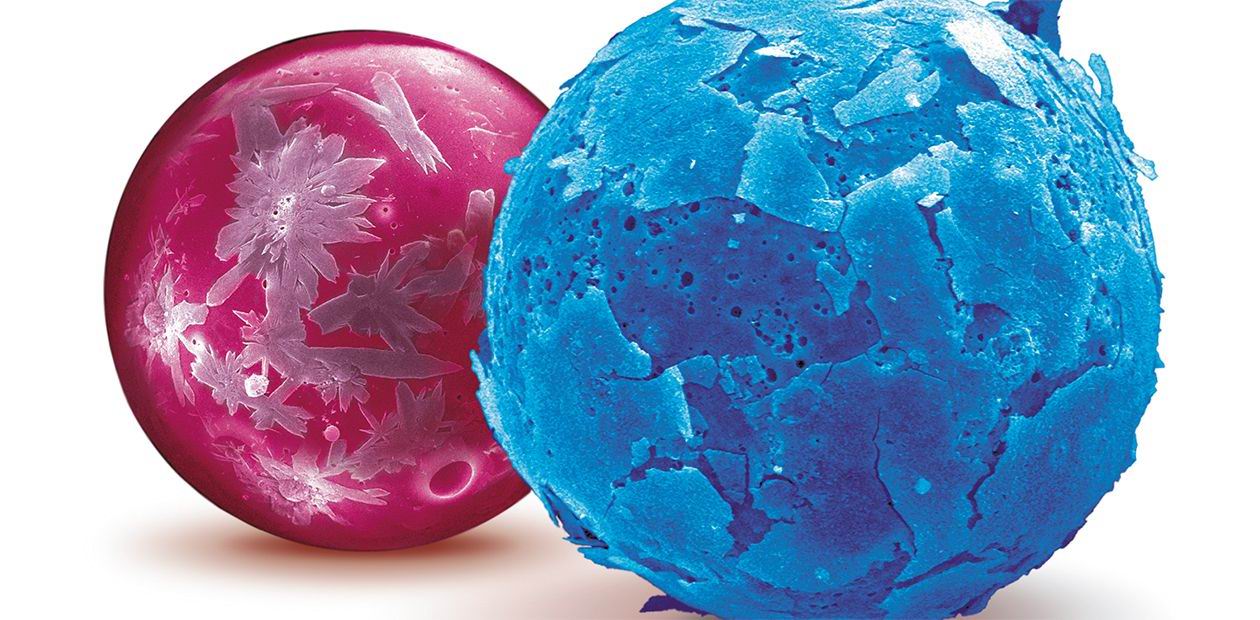Glass Spheres for Solar Gas
Helium, the solar gas, possesses unique properties, which ensure its numerous science and engineering applications. However, extractioning helium from natural gas is extremely expensive. Siberian researchers propose an effective method of preliminary enrichment of gas with the help of microspheres from wastes of thermal power plants. This technology will reduce the net cost of pure helium
The chemical element with the ordinal number 2, helium, in standard conditions is a gas with the greatest chemical inertia ever known. Among all known substances, it has the lowest solubility in liquids, the highest thermal conductivity, and the lowest temperature of condensation. Moreover, it is a non-combustible gas with the smallest molecular weight. Owing to these unique properties, helium is indispensable in environments with superlow temperatures and high pressures; it is also widely used in metallurgy, medicine, production of synthetic materials, and many other fields of science and technology.
There are tremendous amounts of helium on the Earth. It is found in the atmosphere, ocean, and in the Earth crust. In all cases, however, it is mixed with other gases, and its concentration is not very high. The fossil natural gas contains a major part of the helium on our planet and is the main source for helium extraction. A gas deposit is considered rich in helium if the volume fraction of the latter exceeds 0.5 % (for comparison, the volume fraction of helium in atmospheric air is lower by thousands of times). A cryogenic technology based on the method of low-temperature condensation and subsequent rectification of components is currently used all over the world for industrial extraction of helium from the natural gas. Purified helium is liquefied and placed into special storages or it can be used immediately according to the intended purpose.
Activities at superlow temperatures require special frost-resistant materials and equipment of complicated design; therefore, constructing helium-producing plants is extremely expensive. Another drawback of the cryogenic method of helium extraction is the large power expenditures on cooling and liquefaction of natural gas components.
The necessity of improving the basic method of industrial production of helium raises no doubts. Ideas of more cost-effective technologies, which would not require low-temperature production conditions, are permanently discussed.
Wanted: sorter of molecules
One of the most promising ideas of helium separation without using low temperatures is associated with the fact discovered long ago that molecules of light gases can diffuse (percolate) through the crystal lattice of various materials. For instance, hydrogen easily penetrates through plates made of the metal palladium; this knowledge is the basis for implementing the separation of hydrogen-containing gas mixtures in a separator with thin-walled palladium membranes.
The deposits of natural gas richest in helium are located in the USA. The country owns the biggest share of production (approximately 85 % of the worldwide level) and consumption of this gas. Russia’s prospects of helium extraction are related to gas deposits in East Siberia, the largest deposit being the Sobinskoye deposit in EvenkiyaIt is well-known that helium easily penetrates through quartz glass. Quartz, however, is a mineral with a very high melting point; therefore, fabrication of thin quartz tubes or plates is an extremely labor-consuming operation. Besides, reliability of separation devices made of this material is doubtful because of its brittleness. For this reason, until recently the proposed engineering solutions could not compete with the cryogenic technology in terms of either efficiency or capital expenditures.
The interest of specialists in “warm” methods of helium reduction was revived due to the investigations of properties of filling agents for building materials, which were performed at the Institute of Chemistry and Chemical Technology of the Siberian Branch of the Russian Academy of Sciences (Krasnoyarsk). More exactly, we mean the so-called cenospheres – microscopic thin-walled glass spheres which are by-products of processing ash components of coal dust.
Microspheres are thin-walled hollow glass particles with a diameter ranging from several microns to a millimeter. Fabrication of synthetic microspheres with prescribed properties is rather expensive; they are used in high-tech equipment. Nevertheless, there is a more available form of microspheres: the so-called cenospheres, which are by-products of coal burning at thermal power plants.During coal dust burning, the temperature reaches 1200—1700° C. In these conditions, the mineral component (ash) melts and forms extremely fine droplets. They are entrained by the gas flow, gradually inflating owing to expansion of the captured gas inclusions, and finally become solidified, while retaining their shape. The size of the spherical particles thus obtained is 5—400 µm, and the wall thickness is 2—30 µm.
Owing to their low density (0.3—0.7 g/cm3), considerable mechanical strength and thermal stability, excellent heat-insulating properties, stability to chemically aggressive media, and cheapness, cenosphere powders are widely used as a filling agent for building materials.
The variety of cenosphere properties allows researchers to find new spheres of their application. Cenospheres and related new materials and technologies are being studied at the Institute of Chemistry and Chemical Technology SB RAS (Krasnoyarsk)
A study of the phase composition of the cenosphere substance revealed the presence of the crystalline phase of quartz; therefore, the cenosphere walls are permeable for helium. Based on this fact, researchers from the Khristianovich Institute of Theoretical and Applied Mechanics of the Siberian Branch of the Russian Academy of Sciences (ITAM SB RAS) proposed separating a helium-containing gas with the help of these microparticles.
To test this hypothesis, researchers at ITAM SB RAS studied the permeability of various gases inward the cenospheres. The results of chromatographic experiments show that helium is the only component of natural gas that can penetrate through the cenosphere shell.
The next level of research was quantitative experiments. The aim was to find the effect of the gas temperature, composition, and pressure on microsphere permeability. The helium flux was calculated from the rate of the change in pressure inside microspheres, while the internal gas pressure was estimated from the substance balance.
From experiment to technology
Based on experimental information, researchers proposed a scheme for helium reduction in a column filled with microspheres. The process is organized in three stages: pumping of the initial mixture at a high pressure and absorption of helium by microspheres; rapid evacuation or purging of the column with subsequent desorption of helium from microspheres at a low pressure; pumping-out of the gas enriched with the useful product.
Even if subsequent cryogenic treatment is necessary for the final cleaning of impurities from helium, it will be much less expensive.
Industrial implementation of this idea requires engineering calculations for a concentration plant. Helium output can be affected not only by its initial concentration, temperature, and pressures at the separation column input and output, but also by the size and location of the column, fraction and density of packing of microspheres, and by many other factors. It is also necessary to test different operation regimes of a cascade of columns and determine the conditions for reaching the optimal parameters of the process.
To solve this problem, a mathematical model of motion of a helium-containing mixture in a column through a layer of selectively permeable microspheres was developed on thebasis of equations of mechanics of multiphase media.
An important step is verification of the mathematical model and its computational schemes. The modeling results were compared with experimental data obtained on a specially developed test rig. This comparison confirmed the validity of the mathematical description of the physical processes and made it possible to refine the numerical values of their parameters.
The first numerical calculations of the working cycle in an industrial sized column filled with cenospheres demonstrated the possibility of ten-fold enrichment of the mixture, which initially contained 1 % of helium. And this high efficiency is not the limit! Further theoretical calculations and experimental tests are needed.
Cenosheres for practical extraction of helium from natural gas produced in Siberia will be tested shortly. A pilot plant capable of operating in real conditions is under construction. It is our hope that soon Russia would reap benefits from using helium from Siberian deposits.
References
Dolgushev S. V. and Fomin V. M. Helium: its significance for industry; today’s and tomorrow’s methods of its extraction // Preprint ITAM SB RAS. No. 5—2003. Novosibirsk, 2003. 23 pp.
Dolgushev S. V. and Fomin V. M. Cyclic enrichment of the natural gas with helium in a column with glass microspheres // Computational Continuum Mechanics, 2008. No. 4.
Vereshchagin A. S., Vereshchagin S. N., and Fomin V. M. Mathematical modeling of motion of the helium concentration pulse over a column filled with cenospheres // J. Appl. Mech. Tech. Phys., 2007. V. 48. No. 3. P. 92—102.
Vereshchagin S. N., Kurteeva L. I., Rabchevskaya A. A., et al. Using cenospheres of volatile ashes from burning coal for diffuse separation of gases, in: Processes of Combustion and Explosion in Physical Chemistry and Technology of Inorganic Materials // Proc. All-Russia conf., Moscow, 2002.
Vereshchagin A. S., Zinoviev V. N., Pak A. Yu, et al. Estimation of the permeability coefficient of microsphere walls // Vestn. NGU, Ser. Fizika, 2010. V. 5. No. 2. P. 8—16.
Wasteless wastes // SCIENCE First Hands, 2009. No. 6 (30) (Russ.). P. 94—95.
This work was performed within the framework of the Integration Project SB RAS No. 12 and Complex Project SB RAS NSC No. 143.
It was supported by the grants of the President of the Russian Federation (MK-4276.2010.1) and of the Novosibirsk Oblast Administration





